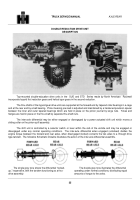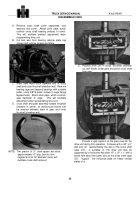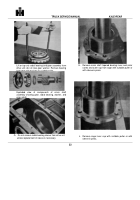TM-5-3805-254-14-P-2 - Page 37 of 894
TRUCK SERVICE MANUAL
AXLE-REAR
D.
Spur pinions for wear or damage to teeth.
E.
Check end of pinion for indications of brinelling
caused by worn splines. Replace the parts if the
splines of the pinion and/or thrushaft are worn,
permitting movement of the pinion on the thru shaft.
F.
Axle shafts for indications of torsional fractures and
run out. Axle shafts should be inspected between
centers to as certain the amount of run out of the
ground surfaces. Run out at the shaft flange and
splines should not exceed .005" total indicator
reading.
REPAIR
A.
all worn or damaged parts. Hex nuts with rounded
comers, all lock washers, oil seals and gaskets
should be replaced at the time of overhaul.
Use only genuine Rockwell Standard parts for
satisfactory service. For example, using gaskets of
foreign material generally leads to mechanical trouble
due to variations in thickness and the inability of
certain materials to withstand compression, oil, etc.
B.
Remove nicks, mars and burrs from machined or
ground surfaces. Threads must be clean and free to
obtain accurate adjustment and correct torque. A fine
mill file or India stone is suitable for this purpose.
Studs must be tight prior to reassembling parts.
C.
All Rockwell Standard bronze bushed axle differential
and interaxle differential pinions should be ball
burnished after bushing installation. Install the
bushing with a small stepped drift. The small O.D.
should be .010" smaller than the bushing burnished
I.D. and
1l
times bushing length. Always install
bushings so end is even with the I.D. chamfer or
about 1/16" below the machined surface.
D.
When assembling component parts use a press
where necessary. Avoid hammering.
E.
Tighten all nuts to specified torque. See torque limits
following service instructions.
Lock wire must not be brittle; use soft iron wire
to prevent possibility of wire breakage.
F.
The burrs, caused by lock washers, at the spot face of
stud holes of cages and covers should be removed to
assure easy re-assembly of these parts. The stud
holes are standard sizes (fractions of an inch) and
may be reamed with standard size reamers. Start the
reamer or drill on side of flange opposite spot face so
the tool will have from 3/8" to 1/2" pilot as it cuts the
burr from the hole.
REASSEMBLE AND INSTALL DRIVE UNIT
The cross shaft assembly must be installed in the carrier first so cross shaft bearing preload can be established without
interference of the thru shaft and pinion assembly. The thru shaft, pinion, bearing and cage may be assembled at the bench and then
installed in the carrier.
35
Back to Top




















